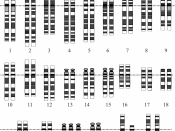Down syndrome is one of the most frequently occurring birth defects in the world. It is a chromosomal abnormality which results in 47 chromosomes, instead of 46, with an extra chromosome being 21. Because the majority of Down syndrome cases affect the twenty-first chromosome, it is commonly called "trisomy 21." Down syndrome is usually caused by a cell division error, which is known as non-disjunction. This occurs when an embryo develops with three number 21 chromosomes instead of two. This excess genetic material alters the course of development and causes the characteristics of this syndrome. The cause of this faulty cell division is still unknown, although there seems to be some relatedness to maternal age. There are two other types of Down syndrome, mosaicism and translocation, but these do not affect individuals as frequently as non-disjunction.
Mosaicism is a mixture of two cell types, leaving the individual with some normal chromosomes of 46, and some affected ones with 47.
Translocation occurs when part of the twenty-first chromosome breaks off and attaches to another cell. The total number of chromosomes is 46, however the excess material from the twenty-first chromosome results in the affects of the syndrome. With translocation, most cases occur sporadically, with no bearing on maternal age. These two types of this syndrome are very rare, being responsible for only 6 or 7 percent of all cases.
Children with Down syndrome are at high risk for health problems. These include congenital heart defects, respiratory problems, increased suseptibility to infections, and/or obstructed digestive tracts. Leukemia has a greater frequency of appearance among children with Down syndrome, and adults are at an increased risk for Alzheimer's disease. Advances in medicine have helped these individuals with their health problems, and generally people with Down syndrome have a life expectancy...


